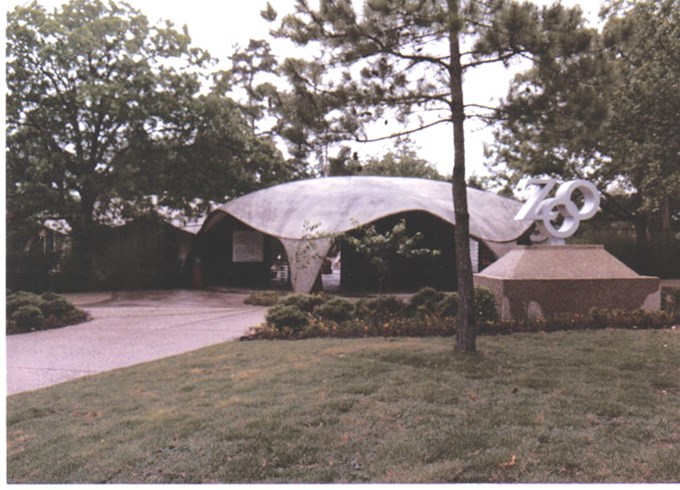
LITTLE ROCK (October 3, 2024) – As the Little Rock Zoo embarks on its Centennial Celebrations, we reflect on a remarkable journey that began in 1924 with just two animals—a timber wolf and a circus-trained brown bear—and has since grown into one of Arkansas’s most cherished institutions. Over the past 100 years, the Little Rock Zoo has not only become a beloved community landmark but also a leader in wildlife conservation, education, and public engagement. From its early days to the present, the Zoo’s mission has always centered on creating a meaningful impact, both locally and globally. As we celebrate this milestone, we honor the Zoo’s legacy of fostering a deep connection between people and animals, and its unwavering commitment to preserving wildlife for future generations.

Early Efforts (1924-1926)
The Little Rock Zoo was originally believed to have been established in 1926. However, recently discovered historical records revealed that the groundwork for what is now the Little Rock Zoo actually began in 1924. The Zoo’s early days were humble, with its first residents later joined by guinea pigs, hawks, deer, and buffalo. These initial animals represented the beginning of the Zoo’s mission to connect people with nature.
Expansion Through the Decades
The 1930s marked a period of significant growth for the Little Rock Zoo. Between 1933 and 1936, several new buildings were completed, including the Big Cat House (now Café Africa), the Monkey House (now the Reptile and Tropical Bird House), and a concession stand that would later become the Elephant House. In 1937, Ruth the elephant was purchased from Engesser Circus, marking the beginning of the Zoo’s long-standing tradition of caring for elephants.
Historic Highlight: Silas Owens Sr. (1907 – 1960)
A key figure in this era of expansion was Silas Owens, Sr., a highly skilled African – American stonemason, carpenter, and farmer from Faulkner County. Known for his distinctive Mixed Masonry style, Owens left an indelible mark on central Arkansas, and his craftsmanship can still be seen in the historic buildings still standing at the Little Rock Zoo.
In 1936, Owens played a crucial role in the construction of both the current Elephant House and the Reptile & Tropical Bird House under a Works Progress Administration (WPA) contract. These buildings, constructed with Owens’ expert touch, have remained in use for nearly 90 years, standing as witness to his remarkable skill and dedication. The timeless design and enduring strength of these structures not only contribute to the Zoo’s rich history but also underscore Owens’ lasting influence on the architectural landscape of central Arkansas.

Growth and Development
Milestones and Challenges
The Zoo celebrated Ruth’s 34th birthday in 1947 with a grand event attended by over 5,000 people, featuring a 1,000-pound cake made by Colonial Bakery. This celebration became a beloved tradition. To this day, elephant keepers at the Little Rock Zoo are known to take elephant birthdays seriously – often cake is involved.

In 1952, the Zoo acquired Big Arkie. He was thought to be the largest alligator found in the United States at the time, measuring 13 feet long and weighing 459 pounds. The arrival of Ellen the elephant in 1954 as a companion for Ruth further expanded the Zoo’s collection.
The 1960s brought challenges as the construction of the I-630 ramp in 1962 cut off plans for southern expansion, eliminating portions of the Civitan Kiddie Zoo, duck pond, and other exhibits. Despite these setbacks, the Zoo continued to grow. The Federal Animal Welfare Act passed in 1966 leading the Little Rock Zoo to move toward creating exhibits that more closely resembled natural habitats. By 1967 and 1968, several new buildings, including the entry complex, small carnivore area, and bear exhibits, were completed. The entry complex was particularly notable, featuring new ticket and office buildings housed in dome-like structures that quickly became iconic due to their unique design. One of these structures, affectionately known as the “Echo Dome” or “The Mushroom” by Zoo staff, still stands in the entry plaza today. Despite the many changes the Zoo has undergone over the years, this distinctive dome has remained a beloved symbol of the Zoo’s entrance, continuing to charm visitors with its retro-futuristic style.

Community Engagement and Education
The 1970s were a transformative period for the Little Rock Zoo, marked by significant projects and the establishment of key programs. The completion of the Big Three Project in 1971 introduced Monkey and Chimpanzee Islands and transformed the Reptile House courtyard into the Tropical Bird House. In 1975, the formation of Friends of the Zoo and the docent program brought new energy to the Zoo, fostering education, volunteerism, and fundraising efforts. These initiatives deepened the Zoo’s connection with the community and expanded its educational outreach, making the Zoo a vital resource for learning and engagement.

The momentum continued into the 1980s with the “Bring Down the Bars” campaign, launched in 1980 to improve animal welfare by moving animals out of barred cages. This effort led to the construction of a new big cat exhibit, which became home to Buck the Bengal tiger. In 1981, the Zoo began charging admission, generating over $3,000 in its first week—funds that helped sustain and grow the Zoo’s offerings. The following year, the new exhibits opened, providing a modern, spacious environment for tigers and jaguars.
A pivotal achievement came in 1985 when the Little Rock Zoo received its first accreditation from the American Association of Zoological Parks and Aquariums (AAZPA), now known as the Association of Zoos and Aquariums (AZA). This accreditation was a testament to the Zoo’s commitment to maintaining the highest standards of animal care and welfare, as well as its dedication to conservation, education, and community engagement.
This milestone was more than just a badge of honor; it marked the Zoo’s evolution into a respected institution within the global zoological community. It underscored the importance of the Zoo’s role not only as a place of recreation but as a leader in conservation and education. This achievement laid the groundwork for future successes, solidifying the Little Rock Zoo’s legacy as a cherished community resource and a guardian of wildlife.


Trudy (left) and Ollie (right), the Zoo’s first Western lowland gorillas. Photo Credit: Karen Caster
The Great Ape Exhibit, which opened in 1988, marked a significant milestone for the Little Rock Zoo, providing a new home for gorillas, orangutans, and chimpanzees, including the Zoo’s first gorillas, Ollie and Trudy. Innovation continued in 1997 with the conversion of the former Chimpanzee Island into an exhibit for ring-tailed, black, and red ruffed lemurs.

The 2000s saw further expansion with the establishment of the Arkansas Zoological Foundation in 2003 strengthening the Zoo’s mission, providing crucial support for its growth and conservation efforts. Followed by the opening of Penguin Pointe and Cheetah Outpost in 2011-2012, made possible by generous donations from the Laura P. Nichols Foundation.

In 2016, Susan Altrui became the Zoo’s first female director, a notable milestone in a field where female leadership is still rare. Her appointment underscored the Zoo’s commitment to diversity and progressive leadership. That year also saw the opening of the Arkansas Heritage Farm, which has quickly become a local favorite, especially among children. This unique space, filled with heritage breeds of domestic animals, offers a nostalgic link to the Kiddie Zoo that once charmed visitors while providing a valuable educational experience about the importance of preserving these unique breeds.
As the expectations of accredited zoos have continued to evolve, the AZA has placed a stronger emphasis on the role of zoos in wildlife conservation. The Little Rock Zoo’s first recorded contribution to international conservation organizations occurred in 2001; today the Zoo works with local and international partners, contributing over $45,000 per year to conserving wildlife and wild places. Nearly every year since 2016, the Zoo has funded one or more staff members to travel abroad to work with our conservation partners in other countries. This has given them the opportunity to participate in knowledge exchange and to have a direct impact on threatened and endangered species.
Further, in 2021, the Zoo began working with Arkansas Game and Fish, the University of Arkansas, and the University of Central Arkansas on a project to protect and conserve native Eastern Collared Lizards (Crotaphytus collaris). The Zoo is breeding lizards for release into glade habitats that are being restored by our partners. This is a species of special concern in Arkansas, and the Zoo is proud to be a part of the effort to conserve them in the wild.
Celebrating a Century of Success
Milestones in the 2020s
The 2020s have been a period of both challenge and triumph for the Little Rock Zoo. Like many organizations, the Zoo faced unprecedented hardships in 2020 when it temporarily closed its doors due to the global pandemic. During this time, the Little Rock Zoo’s future, like that of countless others, was uncertain, and many plans were put on hold. Yet, through resilience and community support, the Zoo has emerged stronger, and ready to continue its mission of conservation, education, and innovation.
In the years that followed, the Zoo achieved several significant milestones that highlighted its dedication to conservation, education, and inclusivity. The opening of new colobus monkey and serval habitats in 2021 exemplified our commitment to providing engaging, immersive experiences for visitors, while the inaugural GloWILD event, featuring animal-themed handcrafted silk lanterns, introduced a new level of creativity and wonder to the Zoo.
A major highlight of 2021 was the birth of Kevin, the first black rhinoceros (Diceros bicornis) born at the Zoo. His birth was a result of breeding recommendations from the Species Survival Plan (SSP) which exists to ensure that zoological populations remain healthy, genetically diverse and self-sustaining. Kevin’s birth represents a significant milestone in the Little Rock Zoo’s ongoing efforts to support these species conservation and breeding programs.

The momentum continued into 2022 with the celebration of the Year of the Tiger, a year dedicated to highlighting this magnificent species. This celebratory year was further punctuated by the birth of three female Malayan tiger cubs—a joyous event that thrilled guests and Zoo staff alike. Their arrival not only added to the excitement of the year but also underscored the Zoo’s commitment to the conservation of this critically endangered species. Watching the cubs grow from tiny cubs to powerful predators has been a source of pride and enthusiasm for everyone involved.

In addition to these conservation milestones, the Little Rock Zoo has made significant strides in creating a welcoming and inclusive environment for all guests. In 2022, the Zoo became the first organization in Arkansas to be certified as Sensory InclusiveTM through KultureCity. This certification ensures that Zoo staff are trained annually to recognize and assist guests with sensory needs, as well as to handle sensory overload situations. Special signage throughout the Zoo marks Quiet and Headphone Zones, and sensory bags equipped with noise-canceling headphones, fidget tools, and other helpful resources are available for guests to borrow during their visit.
Furthering this commitment to inclusivity, the Zoo introduced dual-language signage and began offering Spanish maps, making the Zoo more accessible to a diverse range of visitors.
However, the 2020s have also been a time of reflection and transition. In 2019, the Zoo mourned the loss of Trudy, the world’s oldest living gorilla at the time of her passing. Trudy’s long life was evidence to the excellent care she received, and her passing marked the end of an era for the Zoo. Similarly, 2023 saw the passing of sister grizzly bears Ann and Nona, which also marked the end of grizzly bears at the Little Rock Zoo. The decision not to bring back grizzly bears was made with careful consideration, reflecting the Zoo’s commitment to focusing on species better suited to our environment and future conservation goals.

As the Little Rock Zoo continues to evolve, these milestones serve as a celebration of its past achievements and a guidepost for its future endeavors, ensuring that the Zoo remains a vital part of the community and a leader in animal care and conservation.
Looking Ahead
As the Little Rock Zoo embarks on its next century, it is guided by a renewed Master Plan that will shape the future of this beloved institution. Over the years, zoos have evolved from places where animals were kept in cages to environments where animals thrive in naturalistic habitats, displaying behaviors that educate and inspire. This shift reflects a broader transformation—from a focus on entertainment to a mission centered on conservation, education, and raising awareness about the human impact on wildlife.
Looking ahead, the Little Rock Zoo remains deeply committed to these values. The debut of the traveling exhibit Dragon Kingdom in 2024, in celebration of the Year of the Dragon, and the exciting announcement of a new Komodo dragon exhibit are just the beginning of the innovative experiences planned for the future. These initiatives are not just about showcasing exotic animals; they are part of a larger effort to connect people with nature and foster a deeper understanding of the importance of protecting wildlife.

A banner advertising the upcoming Komodo Dragon exhibit, under construction in 2024. Photo Credit: Misty Waddle
The Little Rock Zoo’s history is demonstrable proof to a century of passion for wildlife and dedication to conservation. From its humble beginnings to its current stature, the Zoo has grown into a beacon of hope and education for all who visit. You’re invited to be a part of this remarkable journey by joining in the centennial celebrations! Your support—whether through visiting, participating in events, or contributing to the Zoo’s mission—helps ensure that the Little Rock Zoo can continue to protect and celebrate wildlife for generations to come.
Posted by Misty Waddle & Dr. Laura Bernstein-Kurtycz on 03 Oct 2024
About the author
Misty Waddle & Dr. Laura Bernstein-Kurtycz
Written by Misty Waddle, with significant contributions from Dr. Laura Bernstein-Kurtycz, Zoo Conservation and Research Coordinator, whose extensive research on the Zoo’s history and timeline provided the foundation for this post. Edited by Joy Matlock, Zoo Development & Marketing Coordinator.



